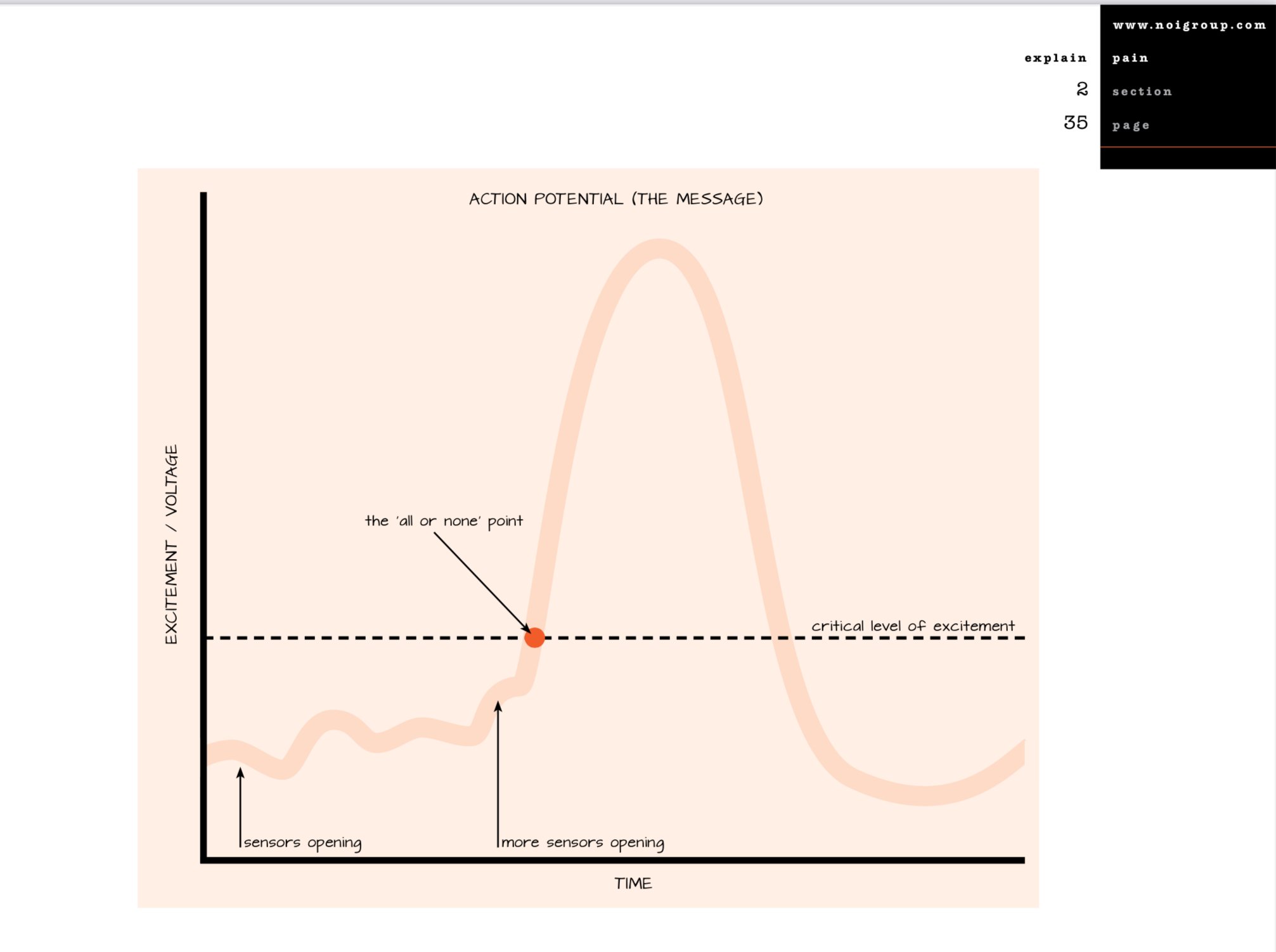What is Pain?
Pain does not equal tissue damage.
Pain is an alarm system
Pain is an alarm to a sensation from the environment received by the brain that is being interpreted as a threat to your body. At the time of an injury, a subconscious part of the brain will sense tissue irritation/inflammation in an area and signal the sensation of pain to your conscious parts of the brain. As the inflammation/irritation resolves, the pain signal to the conscious levels of the brain stops (note the black arrows in the figure below).
Pain is related to your brain’s map of the area
There are many different types of nerves that signal sensation types to the brain. When a sensory nerve gets stimulated , it sends an electrical signal to the spinal cord, and then up to the brain carrying information about the type of stimulation and it’s intensity.
The part of the brain that is in charge of the sensations and movements for the different parts of the body is called the sensorimotor cortex.
From there it is also up to the brain to determine what the sensation is and whether or not it is a threat to the organism.
Pain comes from the brain and is related to how easily a nerve fires
The brain sets the level of stimulation for a nerve to signal a sensation.
The brain also sets the level of stimulation for a nerve that is “Safe” And not harmful to you as an organism.
Sometimes the area of the brain that is in charge of our survival (known as the limbic system, where the fight / flight response is) will develop a connection to the area of the brain that is dedicated to the movement control and sensation of the body part. The brain can set the level of stimulation that tips a signal from the environment into pain lower than what is “ normal .” This can happen especially if the incident that caused the pain in an area involved some sort of trauma (either emotional, physical, or both) or happened at the same time as a period of heavy amounts of life stress.
The brain can also perceive a threat with certain movements or activities and give a pain signal even if there is no stress or injury to the tissues anymore. For example, someone can have perfect squatting or lifting form but still feel pain because the brain has learned to signal pain because of a lifting injury many years ago. Sometimes, especially if the pain signal persists for a long time, a learned pattern can form a "rut" in the subconscious brain that needs to be relearned and retrained.
How to begin to move forward:
Pain Science. Just by consciously learning more and understanding what pain is, where it comes from and how it behaves has been shown in research studies to improve a persons pain experience and begin to re-establish healthy physical activity and movement habits when compared to groups of people who did nothing or just did an exercise program. Here are some resources I recommend to get started. If you’re not up for reading a book, do a search for free podcasts interviews that the authors of these books did on your favorite streaming app.
Mosely explain pain
way out Alan Gordon healing chronic pain
The body keeps the score David Van Der Kolk
What my bones grow healing from complex PTSD - Stephanie Foo
Strong like water - Aundi KolberThis is the Pain Recovery Program created by Alan Gordon, director of Pain Psych Ctr, who wrote a great book The Way Out. It is a FREE 21-day tutorial that includes a group participation feature.
Pain reprocessing self guided materials/find a therapist: https://www.painreprocessingtherapy.com/free-resources
Podcasts
Ezra Klein’s interview of David Van Der Kolk
Stuck but not broken Poly vagal theory podcast by Justin Sunseri
Episode 45 Best of You Podcast Strong like water
Mount Sinai health podcast the road to resilience
2. Use the 2 point pain rule to begin to increase your activity level. You can do anything you want a long as you stay within 2 points of your starting level of pain. If pain starts to increase to that point, stop. Rest for 15-20 minutes. If that doesn't work then stop the activity. This concept is called the envelope of function. By respecting the boundary in the "survival brain" you will be able to do more after about 2-3 more tries
3. Begin a mindfulness practice focused on breathing and counting your breaths to switch off the “flight/flight” part of your brain.
Breath Counting 3 minute “brain-body reset” (you tube)
commit to 5-15 minutes a day.
4. Begin a body scan practice to begin to remap your brain and to grow a healthy brain-body connection.
Soma Healing 45 minute body scan mediation (you tube)
Commit to 5-15 min a day
Commit to short, small moments of awareness and resetting throughout your day.
small bouts of block practice through the day provides the quickest learning of neural skills and establishing new pathways that are used preferentially over old ones.
5. Begin a pain reprocessing practice : https://www.painreprocessingtherapy.com/free-resources
Not all sensations are pain. Give yourself some space, once your sympathetic reaction settles, to get curious and see if there are alternative labels for the sensations you are feeling. Some examples may be “I am sore because I am building strength,” “I am stretching and building flexibility” or “My muscles are engaging and stabilizing me better.”




